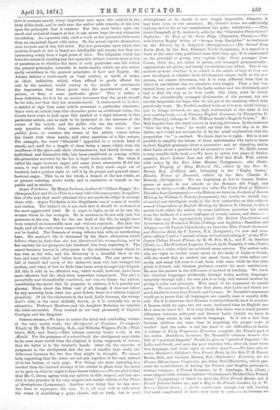CURRENT LITERATURE.
A Treatise on Trade-Marks. By F. M. Adams. (Bell and Sons.}— This book, though small in size as compared with many law-books, is yet a compendious and reliable treatise on the law relating to trade- marks. As a work for the professional lawyer, we can truthfully say that it contains nearly every important case upon this subject in the body of the book, and to each case the author adds remarks of his own upon the principles that it contains. Bat like most books upon one small and technical branch of law, it can never hope for any extensive circulation. As a general rule, such a work as the present is little more than an expanded digest with notes. To the actual reports themselves nine lawyers out of ten will refer. The few principles upon which this modern branch of law is based are intelligible and simple, but they are interesting solely from a legal point of view. The litigation which has been the means of creating any law upon this subject consists more or less of questions as to whether the facts of each particular case fall within the general principles referable to trade-marks, which are also neces- sarily subsidiary to the general principles of Law and Equity. Mr. Adams defines a trade-mark as "any symbol, or mark, or name, or other indication which, when affixed to goods offered for sale in the market, would convey to the minds of purchasers the impression that those goods were the manufacture of some -person, or firm, or some particular place." This is rather a loose definition, for it is by no means necessary that the goods should be for sale, nor that they are manufactured. A trade-mark is, in fact, a symbol or sign that some article possesses a particular character. Since such an article from this character gains an additional value, the Courts have come to look upon this symbol as a right inherent in this particular article, and as such to be protected in the interests of the owner of the article and the public who use the article. The only question which then arises is, whether the name is one publici furls, or whether the owner of the article comes before the Court with clean hands, and other questions of a like nature. For example, the word "Glenfield " appended to a certain kind of starch, and used for a length of time, being a name which, from the smallness of the place and other circumstances, had clearly become an individual and distinctive title, has been considered as coming within the protection accorded by the law to legal trade-marks. But when A called his sugar beetroot sugar, and some years afterwards B did the same, it was decided that all the world, if they made sugar out of beetroot, had a perfect right to call it by its proper and general name, beetroot sugar. This is, on the whole, a branch of the law which, as at present existing, works fairly, and is conducive of benefit to the public and to traders.



































 Previous page
Previous page